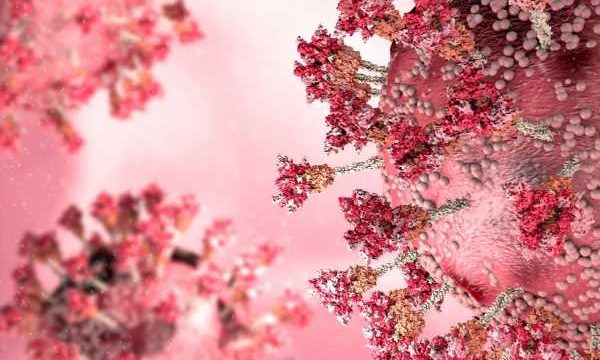In a recent study posted to the bioRxiv* preprint server, researchers explored the virological profiles of novel severe acute respiratory syndrome coronavirus 2 (SARS-CoV-2) Omicron variants.

The presence of SARS-CoV-2 spike (S) protein mutations increases the immune evasiveness, fusogenicity, and pathogenicity of SARS-CoV-2 variants by promoting the binding of the S receptor-binding domain (RBD) with the human angiotensin-converting enzyme (ACE2). The authors of the present study had previously characterized the virological features of SARS-CoV-2 Omicron BA.1 and BA.2. However, the impact of the S L452 residue mutation on the virological characteristics of the novel BA.2-related Omicron variants is unclear.
About the study
In the present study, researchers extended their previous analysis by exploring the virological profiles of five novel BA.2-related Omicron variants (BA.2.9.1, BA.2.11, BA.2.12.1, BA.4, and BA.5) that contain L452R/M/Q mutations in their S RBD.
The sensitivity of BA.2-related Omicron variants to anti-SARS-CoV-2 humoral immunity was assessed by pseudovirus-based assays using pseudoviruses comprising S proteins of BA.2.9.1, BA.2.11, BA.2.12.1, BA.4/5 and BA.2. In addition, cell culture experiments were performed using HEK293-ACE2/TMPRSS2 (human embryonic kidney 293-ACE2/transmembrane serine protease 2) cells, VeroE6/TMPRSS2 cells, and cultured human airway epithelial cells (Calu-3). Yeast surface display assays and cell-based fusion assays were also performed.
Sera were obtained from unvaccinated and vaccinated (breakthrough infections) SARS-CoV-2-positive convalescent patients infected with BA.1 and BA.2. In addition, BA.2-infected hamsters and recombinant(r) BA.2 S RBD-immunized mice were used to evaluate the immune evasiveness of the BA.2-related Omicron variants tested from BA.2 infection-induced immunity. The growth kinetics of the novel Omicron variants tested were assessed in vitro using recombinant SARS-CoV-2 strains viz. WK-521 strain and TY40-385 strain.
The replication dynamics of the BA.2-related Omicron variants were analyzed in vivo using rBA.2-, rBA.2.12.1-, and rBA.4/5-infected hamsters. Pulmonary SARS-CoV-2 ribonucleic acid (RNA) load and nucleocapsid (N) expression were assessed by quantitative reverse transcription-polymerase chain reaction (RT-qPCR) and immunohistochemistry (IHC), respectively. Further, N protein positivity was assessed to compare the efficiency of rBA.4/5 and BA.2 spread. The hamster lungs were also subjected to histopathological analysis to evaluate the pathogenicity of BA.2.12.1 and BA.4/5 in vivo.
Results
BA.2 and all BA.2-related Omicron variants demonstrated resistance to BA.1-positive convalescent sera. In BA.1 breakthrough infection sera, BA.2.9.1, BA.2.11 BA.2 demonstrated comparative sensitivity whereas BA.4/5 and BA.2.12.1 were 2.3-fold and 1.3-fold more sensitive than BA.2. This indicated that the BA.4/5 strains were more resistant to the immunity induced by BA.1 breakthrough infections compared to BA.2.
BA.2 breakthrough infection sera showed stronger anti-SARS-CoV-2 effects compared to BA.2 convalescent sera from the unvaccinated patients. BA.2 demonstrated three-fold higher resistance compared to B.1.1, which indicated that BA.2 infection did not induce efficient anti-SARS-CoV-2 immunity. In contrast, BA.4/5 demonstrated 1.6-fold higher resistance than BA.2. In hamster and mice sera, BA.4/5 evaded responses induced by BA.2 infections. The findings indicated that BA.4/5 was more resistant to BA.1- and BA.2-induced immunity.
In the pseudovirus infectivity assays, BA.4/5 was more infective than BA.2 by 18.3-fold. Yeast surface display assays showed that L452R mutation increased the ACE-2 binding affinity of BA.2 S RBD. Likewise, the cell-based fusion assays showed that in comparison to BA.2 S, the L452R mutation substantially increased BA.2.11 S fusogenicity whereas the S704L mutation (in BA.2.12.1) and the HV69-70del, F486V, and R493Q mutations (in BA.4/5) resulted in a substantially lower fusogenicity. Cell culture experiments showed that L452R-bearing BA.2.11 S and BA.4/5 S demonstrated higher fusogenicity than BA.2 S. The finding was supported by growth capacity experiments, in which the plaques formed by rBA.2.11 and rBA.4/5 infections were larger than those formed by rBA.2 infections.
In the growth kinetic assays, rBA.2.9.1, rBA.2.12.1, and rBA.4/5 replicated more efficiently compared to rBA.2 in human induced pluripotent stem cells (iPSCs)-derived airway epithelial cells. The finding was in accordance with 61-fold and 34-fold greater pulmonary SARS-CoV-2 RNA levels in rBA.2.12.1- and rBA.4/5-infected culture supernatants, respectively, at one day post-infection (dpi). At three and five dpi, the viral RNA levels in the peripheral regions of rBA.4/5-infected hamster lungs were 5.7-fold and 4.2-fold higher compared to rBA.2-infected hamsters, respectively, indicating that rBA.4/5 spread more efficiently than rBA.2. Furthermore, the N protein positivity analysis showed more N-positive cells in rBA.2.12.1- and rBA.4/5-infected hamster lungs compared to rBA.2-infected lungs.
In the in vivo experiments, rBA.2.12.1-infected and rBA.4/5-infected hamsters weighed substantially lesser than rBA.2-infected hamsters. The Rpef values of rBA.4/5-infected hamsters were also substantially lower compared to rBA.2-infected hamsters. This indicated that the L452R/Q-bearing BA.2-related Omicron variants, especially BA.4/5 were more pathogenic than BA.2. The finding was supported by most histopathological changes (bronchitis, hemorrhage, and alveolar damage) with type II pneumocyte cell hyperplasia among rBA.4/5-infected hamsters.
Overall, the study findings highlighted the increased risk of L452R/M/Q-bearing BA.2-related Omicron variants, especially BA.4 and BA.5, to general public health.
*Important notice
bioRxiv publishes preliminary scientific reports that are not peer-reviewed and, therefore, should not be regarded as conclusive, guide clinical practice/health-related behavior, or treated as established information.
- Izumi Kimura, Daichi Yamasoba, Tomokazu Tamura, et al. (2022). Virological characteristics of the novel SARS-CoV-2 Omicron variants including BA.2.12.1, BA.4 and BA.5. bioRxiv. doi: https://doi.org/10.1101/2022.05.26.493539 https://www.biorxiv.org/content/10.1101/2022.05.26.493539v1
Posted in: Medical Science News | Medical Research News | Disease/Infection News
Tags: ACE2, Angiotensin, binding affinity, Bronchitis, Cell, Cell Culture, Coronavirus, Coronavirus Disease COVID-19, Enzyme, Hyperplasia, IHC, immunity, Immunohistochemistry, in vitro, in vivo, Induced Pluripotent Stem Cells, Kidney, Lungs, Mutation, Omicron, Polymerase, Polymerase Chain Reaction, Protein, Pseudovirus, Public Health, Receptor, Respiratory, Ribonucleic Acid, RNA, SARS, SARS-CoV-2, Serine, Severe Acute Respiratory, Severe Acute Respiratory Syndrome, Stem Cells, Syndrome, Transcription, Yeast

Written by
Pooja Toshniwal Paharia
Dr. based clinical-radiological diagnosis and management of oral lesions and conditions and associated maxillofacial disorders.
Source: Read Full Article
